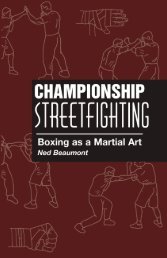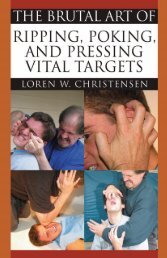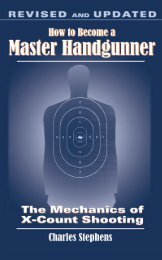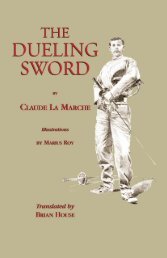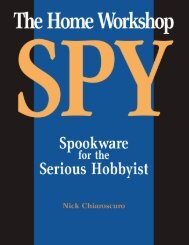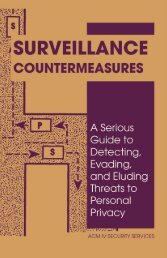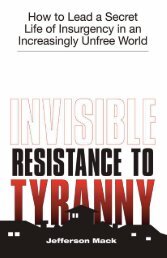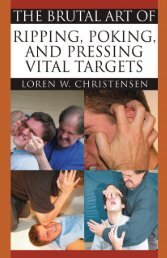Ragnar's Guide to Interviews, Investigations, and ... - Paladin Press
Ragnar's Guide to Interviews, Investigations, and ... - Paladin Press
Ragnar's Guide to Interviews, Investigations, and ... - Paladin Press
Create successful ePaper yourself
Turn your PDF publications into a flip-book with our unique Google optimized e-Paper software.
INTRODUCTION . . . . . . . . . . . . . . . . . . . . . . . . . . . . . . . . . . . . . . . . . . . . . . . . . . . .1<br />
CHAPTER 1:<br />
CHAPTER 2:<br />
CHAPTER 3:<br />
CHAPTER 4:<br />
CONTENTS<br />
WHAT MAKES A SUCCESSFUL INVESTIGATOR? . . . . . . . . . . . . . . . . .3<br />
THE FINE ARTS OF LISTENING AND OBSERVING . . . . . . . . . . . . . . .21<br />
WHAT ARE PRETEXTS AND HOW ARE THEY USED? . . . . . . . . . . . .29<br />
CIVIL VS. CRIMINAL PROCEEDINGS<br />
AND RULES OF EVIDENCE . . . . . . . . . . . . . . . . . . . . . . . . . . . . . . . . . . .47<br />
CHAPTER 5:<br />
CRIMINAL INVESTIGATIONS . . . . . . . . . . . . . . . . . . . . . . . . . . . . . . . . .55<br />
CHAPTER 6:<br />
ONCE WITNESSES ARE IN THE LEGAL PIPELINE . . . . . . . . . . . . . . .65<br />
CHAPTER 7:<br />
SURVIVING A CROSS-EXAMINATION . . . . . . . . . . . . . . . . . . . . . . . . .79<br />
CHAPTER 8:<br />
MILITARY INTERROGATIONS . . . . . . . . . . . . . . . . . . . . . . . . . . . . . . . . .91<br />
CONCLUSION . . . . . . . . . . . . . . . . . . . . . . . . . . . . . . . . . . . . . . . . . . . . . . . . . . . .107<br />
V
CHAPTER<br />
2<br />
THE FINE ARTS OF<br />
LISTENING AND<br />
OBSERVING<br />
LISTENING AND OBSERVING ARE LOST SKILLS in our modern<br />
society. This is true in spite of the fact that some of us spend<br />
up <strong>to</strong> 12 hours a day listening <strong>to</strong> <strong>and</strong> watching the one-eyed<br />
brain destroyer. Some smart old codgers maintain that for<br />
every hour a person watches television, he loses an IQ point.<br />
This situation of passive, noncognitive listening <strong>and</strong> observing<br />
has become so pervasive in our society that people are<br />
shocked <strong>and</strong> sometimes upset when they encounter people<br />
who really do listen <strong>and</strong> observe.<br />
WHAT DOES LISTENING REALLY ENTAIL?<br />
Listening means carefully <strong>and</strong> meticulously training<br />
ourselves <strong>to</strong> hear exactly what people are saying. There’s<br />
nothing magical about this! TV commenta<strong>to</strong>rs often interpret<br />
what someone said, but no interpreter is needed when<br />
we do the job for ourselves. All that is needed is for us <strong>to</strong><br />
21
RAGNAR’S GUIDE TO INTERVIEWS, INVESTIGATIONS, AND INTERROGATIONS<br />
listen <strong>to</strong> what is said—not what we wanted or expected the<br />
person <strong>to</strong> say.<br />
Using Nonverbal Clues<br />
At times nonverbal clues such as eye or h<strong>and</strong> movements,<br />
body posture, or facial expressions will either reinforce<br />
or contradict what is being said. Truly observant investiga<strong>to</strong>rs<br />
will pick these up. But, alas, most of us listen only <strong>to</strong><br />
the extent that we buy time <strong>to</strong> formulate our next response,<br />
which is often specifically designed <strong>to</strong> impress the other guy<br />
by making us look super cool, wise, or perceptive (whether<br />
we really are or not). And so we tend <strong>to</strong> miss these important<br />
clues, as well as much of what is actually being said.<br />
Asking Questions<br />
Those who wish <strong>to</strong> test their listening ability should try<br />
going <strong>to</strong> their next social outing as listeners. Try listening <strong>to</strong><br />
what other people are saying <strong>to</strong> the exclusion of everything else.<br />
Then these “listeners” should question their subjects till it is<br />
clear what they really mean. When their meaning is not clear<br />
or there is an opportunity <strong>to</strong> learn about the cot<strong>to</strong>n futures markets,<br />
the diamond cartel, or fac<strong>to</strong>ry production of ax h<strong>and</strong>les,<br />
for instance, ask precise, pointed questions. One very good<br />
investiga<strong>to</strong>r makes it his policy at otherwise dull parties <strong>to</strong> ask,<br />
“What exactly do you do during an average day?” People should<br />
be wary of guys like him. This chap has the reputation of being<br />
one of the brightest, most outgoing people in the area. He blatantly<br />
practices the fine art of the “five Ws.” People know it,<br />
<strong>and</strong> they still enjoy being around him.<br />
Rather than thinking of you as a fool for asking so many<br />
questions, people will either come <strong>to</strong> believe that you are the<br />
most intelligent person at the party or suspect other motives.<br />
Perhaps suspicion is not common, but it is what goes through<br />
my mind under the uncommon circumstance of finding a<br />
real listener who, I suspect, is also an observer.<br />
22
THE FINE ARTS OF LISTENING AND OBSERVING<br />
Keeping the Conversation Going<br />
What should you do when the conversation lags? Repeat<br />
the last statement made <strong>to</strong> you, but phrase it as a question.<br />
This technique is corny <strong>and</strong> sometimes transparent <strong>to</strong> some,<br />
but usually a miracle occurs when it is practiced. People will<br />
start explaining their entire life his<strong>to</strong>ry in minute detail. This<br />
may sound boring, but it is not wasted effort. All investiga<strong>to</strong>rs<br />
have turned up people with unique talents whom they<br />
later call upon <strong>to</strong> help with their investigations. The people<br />
are flattered, the clients are impressed, <strong>and</strong> all is done at<br />
minimum cost. For example, over the Christmas holidays, I<br />
discovered a husb<strong>and</strong> <strong>and</strong> wife who raised <strong>and</strong> worked sled<br />
dogs. Principally because he was so jacked up about my<br />
interest in him, he jumped in<strong>to</strong> an animal damage case with<br />
such enthusiasm that I eventually had <strong>to</strong> back him off a bit.<br />
Putting Your Skills <strong>to</strong> the Test<br />
For a time I worked with the chief inspec<strong>to</strong>r of the Illinois<br />
State Police. He’s retired now, so I can tell this s<strong>to</strong>ry. He <strong>and</strong> his<br />
fellow investiga<strong>to</strong>rs used <strong>to</strong> play a little game with each other<br />
when they went <strong>to</strong> social functions outside their official sphere.<br />
The challenge was <strong>to</strong> find out the bra size of as many women at<br />
the party as possible. The one with the most information won.<br />
Guessing was not allowed. The woman or her husb<strong>and</strong> had <strong>to</strong><br />
reveal exact information, or it didn’t count. The investiga<strong>to</strong>rs<br />
were on their honor, <strong>and</strong>, of course, they cross-checked their<br />
information. By the way, this was the Midwest, not Hollywood,<br />
so getting this information really was <strong>to</strong>ugh. The first guy <strong>to</strong><br />
approach a woman could always deploy a pretext about a free<br />
swimsuit, but what the others did is beyond me. I personally had<br />
no chance in that contest. (More about pretexts in Chapter 3.)<br />
OBSERVING IS MORE THAN SEEING<br />
Like listening, observance is learned. Becoming superobservant<br />
is entirely a matter of training <strong>and</strong> practice. One<br />
23
RAGNAR’S GUIDE TO INTERVIEWS, INVESTIGATIONS, AND INTERROGATIONS<br />
novice investiga<strong>to</strong>r used <strong>to</strong> put a very small pebble in his<br />
shoe. Every time he stepped on the pebble he reminded himself<br />
<strong>to</strong> observe br<strong>and</strong>s of cigarettes or cigars, booze, watches,<br />
br<strong>and</strong>s of suits, colors of vehicles, condition of clothes,<br />
h<strong>and</strong>s, hats, shoes, <strong>and</strong> whatever else. Soon it was such fun<br />
<strong>and</strong> he was sufficiently conditioned that he removed the<br />
s<strong>to</strong>ne. But he found he also had <strong>to</strong> continually remind himself<br />
<strong>to</strong> listen as well as observe.<br />
Sir Arthur Conan Doyle in “A Sc<strong>and</strong>al in Bohemia,” a<br />
short s<strong>to</strong>ry in The Adventures of Sherlock Holmes, used the<br />
example of Watson’s not knowing the number of steps that<br />
led from one room <strong>to</strong> another <strong>to</strong> show how unobservant<br />
most people are.<br />
“When I hear you give your reasons,” [Watson]<br />
remarked, “the thing always appears <strong>to</strong> me <strong>to</strong> be so<br />
ridiculously simple that I could easily do it myself,<br />
though at each successive instance of your reasoning<br />
I am baffled until you explain your process. And<br />
yet I believe that my eyes are as good as yours.”<br />
“Quite so,” [Holmes] answered, lighting a cigarette,<br />
<strong>and</strong> throwing himself down in<strong>to</strong> an armchair.<br />
“You see, but you do not observe. This distinction<br />
is clear. For example, you have frequently seen the<br />
steps which lead up from the hall <strong>to</strong> this room.”<br />
“Frequently.”<br />
“How often?”<br />
“Well, hundreds of times.”<br />
“How many are there?”<br />
“How many? I don’t know.”<br />
“Quite so! You have not observed. And yet you<br />
have seen. That is just my point. Now, I know that<br />
there are seventeen steps, because I have both<br />
seen <strong>and</strong> observed.”<br />
24
THE FINE ARTS OF LISTENING AND OBSERVING<br />
Perhaps this fictional example doesn’t seem useful—after<br />
all, why would people need <strong>to</strong> know how many steps lead <strong>to</strong><br />
another room?—but how many of us learn <strong>to</strong> observe rings,<br />
tat<strong>to</strong>os, scars, whether people can read or write, or whether<br />
their h<strong>and</strong>s are those of a laborer or an office worker?<br />
USING SILENCE TO LISTEN AND OBSERVE<br />
Those who are reading this book for defensive purposes<br />
because they wish <strong>to</strong> outfox an investiga<strong>to</strong>r should keep in<br />
mind that great investiga<strong>to</strong>rs/interroga<strong>to</strong>rs have an unusual<br />
ability <strong>to</strong> listen <strong>and</strong> observe. Many of them do this by deploying<br />
silence <strong>to</strong> their advantage. Worse even than encountering<br />
a listener, Americans cannot st<strong>and</strong> silence once they start talking<br />
about themselves. Japanese businessmen who use silence<br />
as a negotiating <strong>to</strong>ol frequently hack their American counterparts<br />
<strong>to</strong> ribbons. The Japanese just sit there without saying a<br />
word, eventually taking all the marbles.<br />
EVALUATING THE LISTENING<br />
AND OBSERVATION SKILLS OF OTHERS<br />
It is a little known <strong>and</strong> infrequently reported fact, but<br />
one of the duties of a private investiga<strong>to</strong>r involves evaluating<br />
the listening abilities, as well as social proclivities, of anyone<br />
involved in their cases. Well-financed clients who are determined<br />
<strong>to</strong> win spend really big bucks finding out how well<br />
potential jurors listen, their educational levels, how much<br />
they have traveled, what they do for a living, <strong>and</strong>, if possible,<br />
their religious <strong>and</strong> social biases.<br />
On the basis of this information, jurors judged <strong>to</strong> be favorable<br />
<strong>to</strong> the client are selected. As long as investiga<strong>to</strong>rs openly<br />
talk <strong>to</strong> friends <strong>and</strong> acquaintances about potential jurors’<br />
background <strong>and</strong> biases <strong>and</strong> do not attempt <strong>to</strong> influence them<br />
about that specific case, it is not considered jury tampering.<br />
25
RAGNAR’S GUIDE TO INTERVIEWS, INVESTIGATIONS, AND INTERROGATIONS<br />
Absolutely as<strong>to</strong>unding numbers of potential jurors must<br />
be evaluated. This checking is never quick, simple, or cheap.<br />
Everything must be done before selection <strong>and</strong> impaneling.<br />
Most investiga<strong>to</strong>rs figure $20,000 <strong>to</strong> evaluate a list of 100<br />
potential jurors. Clients must want <strong>to</strong> win very badly <strong>and</strong><br />
have very deep pockets <strong>to</strong> pull this off.<br />
KINESICS INTERVIEWING<br />
Kinesics interviewing is the art of evaluating body language<br />
in an effort <strong>to</strong> determine truth or falsehood. Kinesics<br />
studies nonverbal body motions such as eye movements,<br />
shrugging, crossing <strong>and</strong> uncrossing of the legs, <strong>to</strong>uching,<br />
pointing, <strong>and</strong> h<strong>and</strong> movements <strong>to</strong> suggest whether the person<br />
being interviewed is lying or telling the truth. The system<br />
relies heavily on investiga<strong>to</strong>rs with great observation<br />
<strong>and</strong> listening abilities. Investiga<strong>to</strong>rs using kinesics must be<br />
patient, capable of negotiating from silence, <strong>and</strong> able <strong>to</strong> continually<br />
ask the correct questions in such a way that the<br />
interviewee is forced <strong>to</strong> consider the ramifications <strong>and</strong> implications<br />
of his answers.<br />
Note carefully that this technique is referred <strong>to</strong> as an art,<br />
not a science. Most investiga<strong>to</strong>rs who use kinesics maintain that<br />
it is not a hard science because it cannot be tested <strong>and</strong> replicated.<br />
Some witnesses by their very nature just will not look<br />
strangers in the eye, or they become nervous, crossing <strong>and</strong><br />
uncrossing their legs, without any deep-seated larcenous intent.<br />
Therein lies the failing of kinesics for many investiga<strong>to</strong>rs.<br />
A benchmark must be established for each individual, <strong>and</strong><br />
this takes a great deal of time. Some investiga<strong>to</strong>rs try <strong>to</strong> get<br />
around <strong>to</strong> eight or ten potential witnesses per day. Just talking<br />
<strong>to</strong> <strong>and</strong> establishing rapport with all these folks is difficult<br />
enough without trying <strong>to</strong> establish a point of reference relative<br />
<strong>to</strong> their individual body movements. A valid kinesics<br />
evaluation takes at least two or three hours. If the subject of<br />
26
THE FINE ARTS OF LISTENING AND OBSERVING<br />
the interview is a hardened criminal or an experienced witness,<br />
the interview must be much longer.<br />
Kinesics is the trendy stepchild of witness interviewing <strong>and</strong><br />
cycles in <strong>and</strong> out of favor on a regular basis. In real life there is<br />
definitely a place for kinesics evaluation, but investiga<strong>to</strong>rs must<br />
be trained <strong>to</strong> use it properly. Some witnesses are naturally<br />
shifty looking, cannot establish eye contact, <strong>and</strong> do a poor job<br />
of representing their case on the st<strong>and</strong>. Good private investiga<strong>to</strong>rs<br />
highlight these characteristics in their reports <strong>to</strong> clients so<br />
that these people will not be called as witnesses.<br />
As with many investiga<strong>to</strong>rs, I have made only nominal use<br />
of kinesics. If a witness will talk <strong>to</strong> me straight out after hearing<br />
my reason for wanting information <strong>and</strong> he has no other<br />
obvious biases, I usually assume he is telling the truth. For<br />
instance, asking a witness if he observed open cans or bottles<br />
of booze at a crash site usually will elicit a truthful response.<br />
Most citizens are happy <strong>to</strong> help. Either they recall such action,<br />
or they do not. (Of course, an investiga<strong>to</strong>r has a duty <strong>to</strong> evaluate<br />
possible biases, but more about that later.)<br />
Police investiga<strong>to</strong>rs who use grueling eight- or ten-hour<br />
interrogations tend <strong>to</strong> put more faith in reading body language<br />
than fast-moving private investiga<strong>to</strong>rs. We will address this<br />
issue in Chapter 5 on criminal investigations, but often cops<br />
make it so easy <strong>and</strong> tempting <strong>to</strong> confess that they sometimes<br />
drag confessions that aren’t necessarily accurate out of people.<br />
27
RAGNAR’S GUIDE TO INTERVIEWS, INVESTIGATIONS, AND INTERROGATIONS<br />
TIPS FOR POTENTIAL WITNESSES<br />
1. Do not be deceived by an investiga<strong>to</strong>r’s use of<br />
silence. This is a deliberate technique designed<br />
<strong>to</strong> make you uncomfortable enough <strong>to</strong> start talking—<strong>and</strong><br />
keep talking until you have spilled<br />
everything.<br />
2. If an investiga<strong>to</strong>r starts repeating your last statement<br />
in the form of a question, just remain<br />
silent. Do not start explaining what you meant<br />
or adding more details.<br />
3. Listen carefully <strong>to</strong> the questions <strong>and</strong> provide<br />
only specific answers <strong>to</strong> them—do not provide<br />
more than what’s being asked.<br />
4. Make eye contact, do not cross your arms or<br />
legs, showing a defensive posture.<br />
5. Be especially quiet <strong>and</strong> cautious around a person<br />
who is obviously a listener <strong>and</strong> observer.<br />
This won’t keep him from getting a lot of information,<br />
but it might keep you from giving away<br />
the s<strong>to</strong>re.<br />
6. Try <strong>to</strong> maintain one posture without much<br />
“body language.” For some people in some cultures<br />
this is impossible. Don’t worry—few investiga<strong>to</strong>rs<br />
rely heavily on kinesics unless the witness<br />
is obvious about it.<br />
28



